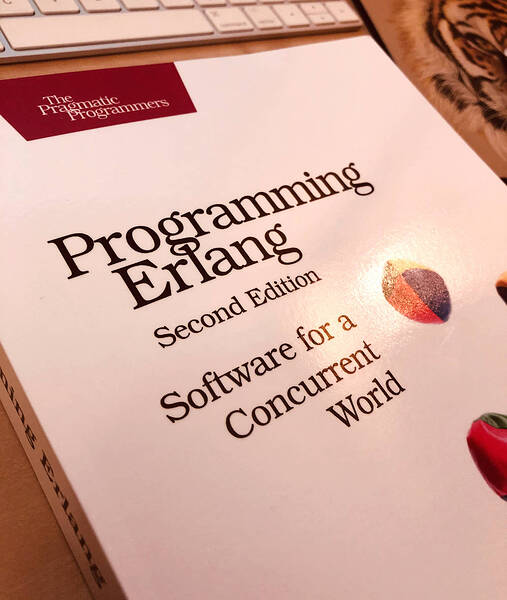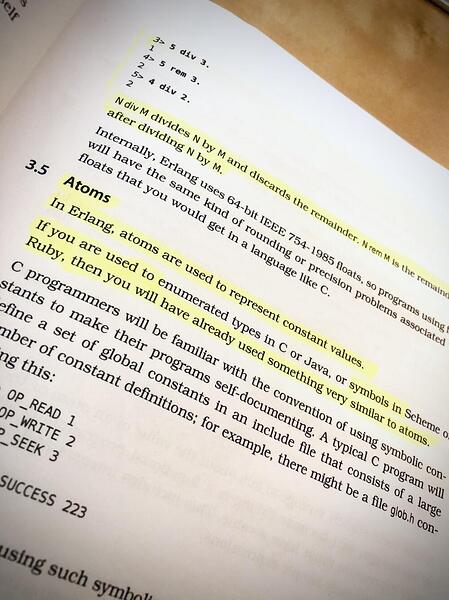Finally managed to finish chapter 2 
Here’s my solution, which is essentially the same as yours 
-module(afile_client).
-export([ls/1, get_file/2, put_file/3]).
ls(Server) ->
Server ! {self(), list_dir},
receive
{Server, FileList} ->
FileList
end.
get_file(Server, File) ->
Server ! {self(), {get_file, File}},
receive
{Server, Content} ->
Content
end.
put_file(Server, FileName, FileContent) ->
Server ! {self(), {put_file, FileName, FileContent}},
receive
{Server, Content} ->
Content
end.
-module(afile_server).
-export([start/1, loop/1]).
start(Dir) -> spawn(afile_server, loop, [Dir]).
loop(Dir) ->
receive
{Client, list_dir} ->
Client ! {self(), file:list_dir(Dir)};
{Client, {get_file, File}} ->
Full = filename:join(Dir, File),
Client ! {self(), file:read_file(Full)};
{Client, {put_file, FileName, FileContent}} ->
Client ! {self(), file:write_file(FileName, FileContent)}
end,
loop(Dir).
1> c(afile_client).
{ok,afile_client}
2> c(afile_server).
{ok,afile_server}
3> FileServer = afile_server:start(".").
<0.104.0>
4> afile_client:get_file(FileServer, "afile_server.erl").
{ok,<<"-module(afile_server).\n-export([start/1, loop/1]).\n\nstart(Dir) -> spawn(afile_server, loop, [Dir]).\n\nloop(Di"...>>}
5> afile_client:put_file(FileServer, "new_file.erl", "Some content").
ok
6> afile_client:get_file(FileServer, "new_file.erl").
{ok,<<"Some content">>}
Thoughts so far
I’m loving this book!
I especially like how Joe is expressing what’s what in Erlang in no uncertain terms and I like his analogies. The way he talks about Modules in Erlang being like classes in OOP (and that processes are like objects) and that processes are lightweight virtual machines - I don’t think I’ve heard anyone else say that before.
Like @DevotionGeo I am also growing to like some of Erlang’s syntax, for instance I think atoms ( module/function names) being lowercase makes sense in a functional language because you use them a lot as you are forever calling some module:function(). I can also see why the . might have been used because it would be handy if you’re sending a lot of commands via a terminal, you could almost ‘talk’ to it by means of sending the commands as a series of sentences in a paragraph. However I am still unconvinced about it when writing everyday code in files.
I also like how he talks about there being a beautiful symmetry between the client and server - it’s just small things like this that help you see the thought behind things and it goes some way to shape the way you feel about things yourself too.
Can’t wait to read more! I bet you are flying ahead @Rainer!!





 I am hoping to tonight just before bed tho
I am hoping to tonight just before bed tho 








 Usually this is just short time when I’m stressed, but the last weeks were not good… However, now I’m relaxing with Erlang at the evening
Usually this is just short time when I’m stressed, but the last weeks were not good… However, now I’m relaxing with Erlang at the evening 
 even though Maths was actually my strongest subject and I was often top of the class, now, I am lost without a calculator!
even though Maths was actually my strongest subject and I was often top of the class, now, I am lost without a calculator!  Although what’s in the book is technically correct
Although what’s in the book is technically correct